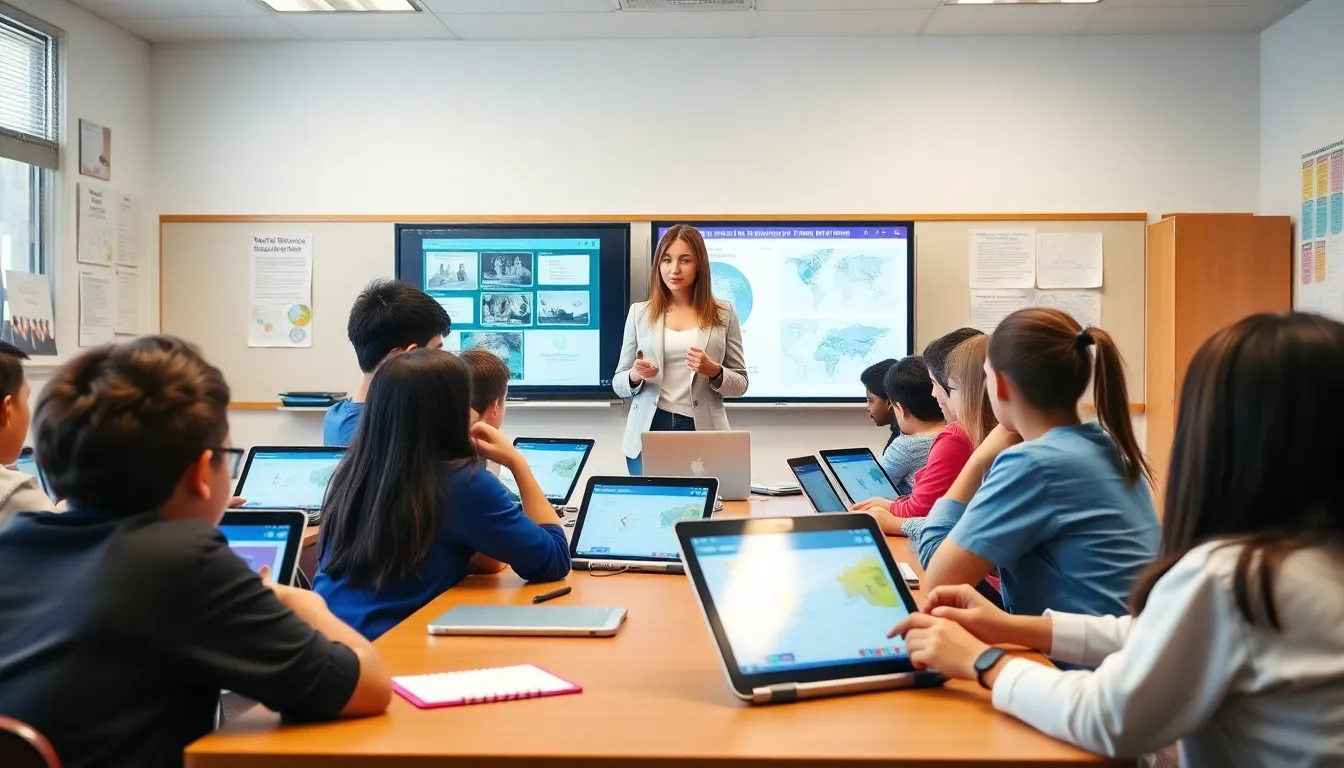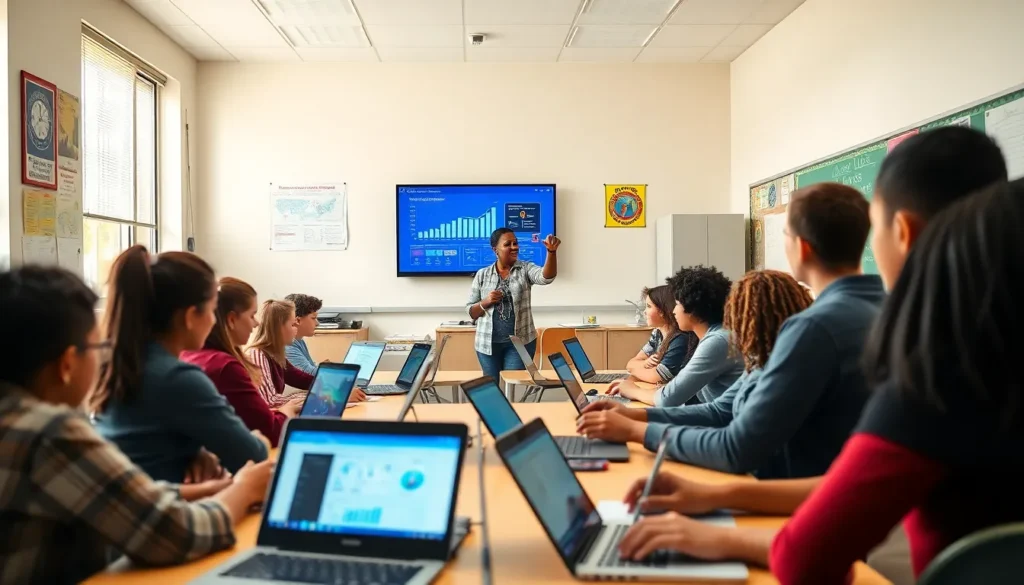In today’s fast-paced world, education is evolving rapidly, and digital curriculum is at the forefront of this transformation. Schools and educators are increasingly turning to technology to enhance learning experiences, making education more accessible and engaging. With interactive tools and resources, digital curriculum not only caters to diverse learning styles but also prepares students for a tech-driven future.
As traditional teaching methods give way to innovative digital solutions, it’s essential to understand the impact of this shift. From online courses to virtual classrooms, the digital curriculum offers endless possibilities for both students and teachers. Embracing these changes can lead to improved outcomes and a more personalized approach to education, ensuring that every learner can thrive in an ever-changing landscape.
Table of Contents
ToggleOverview of Digital Curriculum
Digital curriculum refers to educational content delivered and accessed through technology. It encompasses a wide range of resources, including online courses, interactive modules, and multimedia presentations, all designed to enrich the learning experience.
Definition of Digital Curriculum
Digital curriculum consists of structured educational materials presented in an electronic format. It includes programs, lessons, activities, and assessments accessed via computers, tablets, or smartphones. Examples of digital curriculums include Learning Management Systems (LMS) like Moodle and platforms such as Khan Academy. This definition emphasizes the integration of digital tools that provide various learning experiences tailored to individual needs and preferences.
Importance in Modern Education
Digital curriculum plays a crucial role in enhancing modern education by providing flexibility and accessibility. It allows students to learn at their own pace, accommodating diverse learning styles and schedules. Digital curriculums often integrate real-time feedback, enabling instructors to adapt teaching strategies to individual student progress. Research indicates that technology-enhanced learning increases engagement and retention rates, further underscoring its significance in contemporary educational environments. This adaptability fosters a more inclusive learning atmosphere where all students can thrive.
Types of Digital Curriculum

Digital curricula come in various forms, each designed to cater to specific educational needs. Understanding these different types enhances educators’ ability to implement effective digital learning strategies.
Subject-Specific Digital Curricula
Subject-specific digital curricula focus on particular disciplines such as math, science, or language arts. These targeted resources provide specialized content aimed at enhancing comprehension and mastery within a specific subject area. For example, platforms like Khan Academy offer tailored lessons in mathematics, while programs like Rosetta Stone focus on language acquisition. Subject-specific digital curricula often include interactive exercises, quizzes, and assessments that reinforce learning objectives, allowing students to build proficiency and confidence in their chosen subjects.
Comprehensive Digital Curriculum Systems
Comprehensive digital curriculum systems integrate various subjects and learning materials into a cohesive framework, supporting a broad range of educational goals. These platforms, such as Google Classroom or Canvas, enable teachers to organize coursework, track student progress, and share resources efficiently. Comprehensive systems often feature diverse content types, including videos, readings, and discussion boards, facilitating a holistic learning experience. By combining various elements into one system, these digital curricula provide educators with tools to create personalized learning paths, ensuring that all students can access relevant content tailored to their individual needs.
Benefits of Digital Curriculum
Digital curriculum offers numerous advantages that enrich the educational landscape. It enhances learning experiences, making them more tailored and engaging for students.
Personalized Learning Experiences
Digital curriculum facilitates personalized learning by allowing students to progress at their own pace. It accommodates different learning styles and preferences, ensuring that each learner can access materials suited to their needs. For instance, platforms like Khan Academy adapt instructional content based on individual student performance, providing customized pathways for mastery. Real-time analytics enable educators to monitor progress, identify strengths and weaknesses, and adjust instructional strategies accordingly. This data-driven approach fosters an inclusive learning environment, where each student’s unique journey is supported.
Enhanced Engagement and Interactivity
Digital curriculum significantly enhances student engagement through interactive elements and multimedia resources. Incorporating videos, simulations, and gamified content captures students’ attention and motivates them to explore subjects in depth. Tools like interactive quizzes provide immediate feedback and promote active participation, making learning both enjoyable and effective. This increased interactivity leads to higher retention rates as students are more likely to remember concepts presented in engaging formats. Overall, digital curriculum transforms traditional learning into a dynamic experience, encouraging students to take an active role in their education.
Challenges and Considerations
Digital curriculum integration presents various challenges and considerations that schools and educators must navigate to ensure successful implementation and maximized benefits.
Accessibility and Equity Issues
Access to digital curricula can vary significantly across different student populations. Students in low-income areas frequently lack reliable internet connections or access to devices, hindering their ability to engage fully with digital materials. Schools must address these disparities by providing necessary resources and support, ensuring all students can participate in digital learning modalities. Furthermore, considerations must include the variability in digital literacy among students and parents; providing training and resources can enhance engagement and empower all families to assist in their children’s education.
Teacher Training and Support
Successful digital curriculum implementation depends heavily on adequate teacher training and ongoing support. Educators often require professional development to become proficient in using new technologies and platforms effectively. School districts must prioritize comprehensive training programs that cover both technical skills and instructional strategies for integrating digital resources in lessons. Additionally, fostering a culture of collaboration and support among educators can enhance shared learning experiences, facilitating more effective implementation of digital curriculum across various classrooms. Without these crucial support systems, the potential of digital curriculum may not be fully realized.
Future Trends in Digital Curriculum
Digital curriculum continues to evolve, integrating cutting-edge technologies to enhance learning. Key trends include the integration of artificial intelligence (AI) and the use of adaptive learning systems, which shape the future of education.
Integration of AI and Technology
AI technology personalizes learning experiences. It analyzes student data to identify strengths and weaknesses, adapting content accordingly. Tools such as chatbots provide 24/7 assistance, answering questions and offering resources. AI-driven platforms can recommend tailored learning pathways, helping students achieve individual goals. This adaptive approach increases engagement and encourages self-directed learning, catering to diverse student needs.
Adaptive Learning Systems
Adaptive learning systems adjust educational content in real-time based on student performance. These systems use data analytics to customize instructional strategies, ensuring learners receive appropriate challenges and support. Platforms such as DreamBox Learning and Smart Sparrow exemplify this trend by offering interactive, personalized lessons. Adaptive learning also promotes mastery learning, allowing students to grasp concepts before progressing. This individualized approach enhances retention and fosters a deeper understanding of the material, paving the way for improved educational outcomes.
The shift towards digital curriculum represents a pivotal moment in education. By harnessing technology, educators can create more engaging and personalized learning experiences that cater to diverse student needs. The integration of innovative tools and platforms not only enhances accessibility but also fosters a more interactive environment.
As schools continue to adapt to these changes, it’s essential to address challenges such as equity and access. Ensuring that all students have the resources they need is crucial for maximizing the benefits of digital learning. With ongoing support and professional development for educators, the full potential of digital curriculum can be realized.
Looking ahead, the incorporation of AI and adaptive learning systems will likely further transform educational landscapes. This evolution promises to create even more tailored learning experiences, paving the way for improved outcomes in the future.









